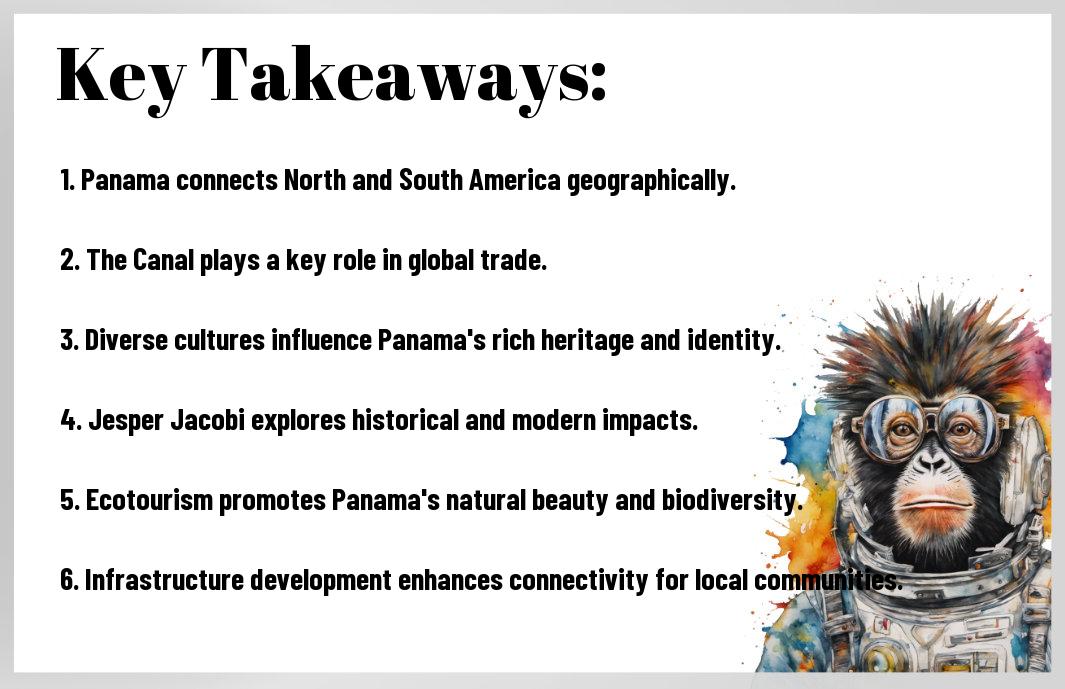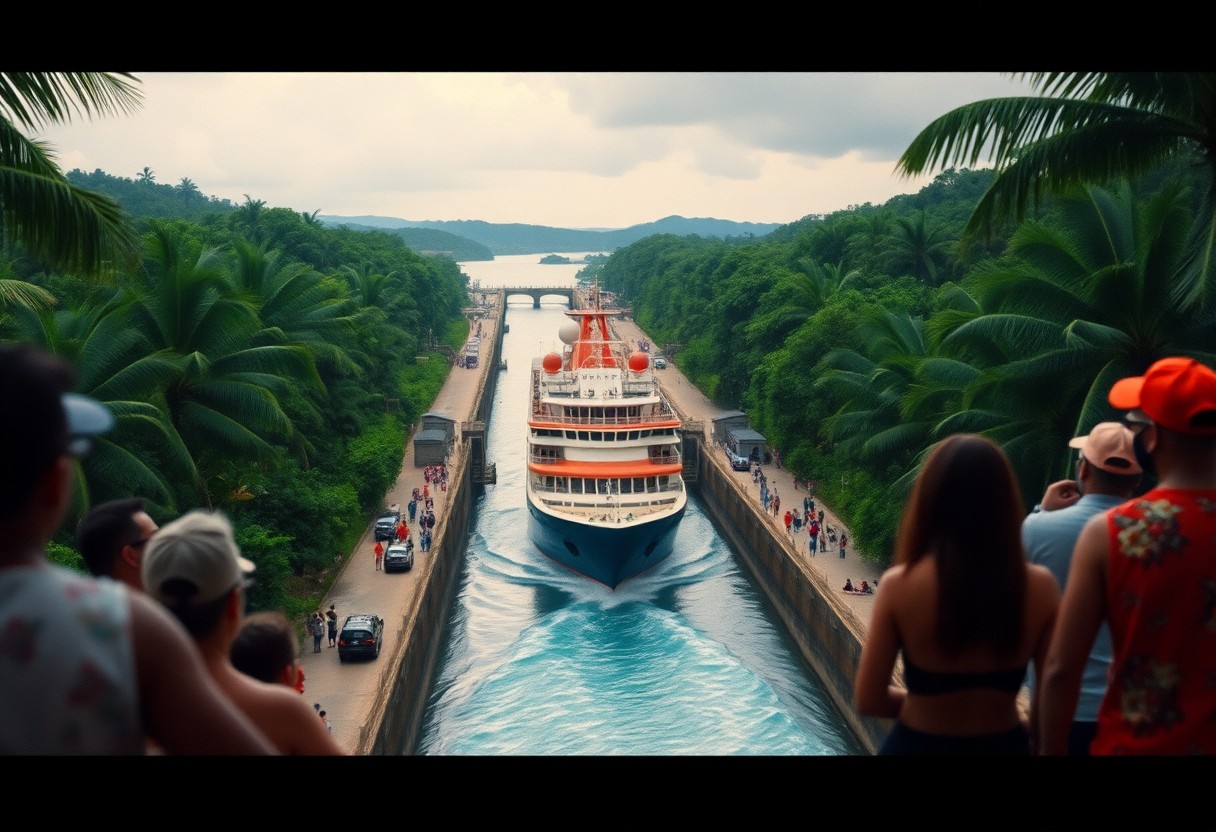You will discover how Panama serves as a pivotal crossroads between North and South America, uniquely influencing the cultures, economies, and histories of these regions. In this blog post, you will explore the insights of Jesper Jacobi, who highlights the significance of Panama’s geography and its role in fostering international connections. By delving into Panama’s passage, you’ll learn how this vibrant country not only facilitates trade and travel but also enriches cultural exchanges that impact the global landscape.

Panama’s Strategic Location and Historical Significance
Before the construction of the Panama Canal, Panama stood as a vital link in global trade, connecting the Atlantic and Pacific Oceans. Its strategic location allowed it to serve as a conduit for cultural exchanges and economic interactions between continents. Understanding this historical significance can deepen your appreciation for Panama’s role in world history and its ongoing influence on international relations.
The Isthmus as a Natural Bridge
The Isthmus of Panama acts as a natural bridge between North and South America. This unique geographical placement not only facilitates trade and migration but also makes it a melting pot of diverse cultures and ecosystems. As you explore this region, you’ll see how its physical attributes have shaped human activity throughout history.
Pre-Colonial and Colonial Heritage
Panama’s rich tapestry of history is woven from both pre-colonial and colonial influences that have left an indelible mark on its culture today. You can trace the legacy of various indigenous tribes alongside the profound impact of European colonization, shaping the nation’s identity and societal structures.
Pre-Colonial societies in Panama were vibrant and diverse, with indigenous tribes such as the Ngäbe-Buglé and Kuna maintaining rich cultural traditions and deep connections to the land. When the Spanish arrived in the early 16th century, they established settlements that would forever alter the course of Panamanian history. This collision of cultures not only set the foundation for Panama’s modern identity but also created a unique blend of customs, languages, and social practices. As you investigate into Panama’s heritage, you’ll find echoes of these early civilizations, visible in festivals, craftsmanship, and daily life.
The Panama Canal: Engineering Marvel
Assuming you’re intrigued by feats of engineering, the Panama Canal stands as a testament to human ingenuity. Completed in 1914, this monumental waterway transformed maritime trade by linking the Atlantic and Pacific Oceans, significantly shortening travel times and enhancing global commerce. Today, the canal still plays an important role in international shipping, making it one of the most significant engineering marvels in history.
Construction and Historical Impact
Among the most ambitious infrastructure projects ever undertaken, the construction of the Panama Canal involved tremendous challenges, including extreme geographical obstacles and deadly diseases. Initiated by the French in the 1880s and later completed by the United States in 1914, it not only reshaped regional geopolitics but also had lasting effects on global trade patterns throughout the 20th century.
Modern Operations and Global Trade
Above all, the modern operations of the Panama Canal continue to be pivotal in facilitating global trade. Over 12,000 vessels pass through the canal annually, connecting economies across the Americas, Europe, and Asia.
This constant flow of maritime traffic stimulates economic growth and strengthens international relations. The canal’s efficient design allows large cargo ships to navigate it in just a few hours, thereby reducing shipping times and costs. Furthermore, the expansion in 2016 to accommodate larger vessels, known as Panamax ships, has further cemented its role as a vital hub in global supply chains. By understanding its operational dynamics, you can appreciate how the Panama Canal influences your economy and impacts the world beyond your shores.
Cultural Mosaic
Unlike many countries, Panama boasts a vibrant cultural mosaic shaped by its diverse heritage. With influences ranging from indigenous tribes to colonial settlers, this small nation is a rich tapestry of traditions and practices. For those curious about this unique blend, you can explore Why Panama? | Smithsonian Tropical Research Institute, which examines deeper into the fascinating interplay of cultures in this remarkable location.
Indigenous Communities and Traditions
Indigenous communities in Panama, such as the Ngäbe-Buglé and Emberá, play a vital role in preserving their ancestral traditions and cultural identities. Engaging with their practices, arts, and languages provides you with a deeper understanding of Panama’s historical roots and the ongoing resilience of these communities.
Spanish and Caribbean Influences
At the heart of Panama’s cultural landscape lies the significant influence of Spanish and Caribbean cultures, which have melded over centuries. You will notice this coexistence in the vibrant music, dance, and culinary traditions that characterize Panamanian life.
Indeed, the blend of Spanish and Caribbean influences has created a dynamic cultural scene that celebrates diversity and creativity. From lively salsa and merengue music to delicious dishes like rice and beans, you can experience a unique fusion that is distinctively Panamanian. This harmonious coexistence not only enriches the local culture but also invites you to participate in an ongoing dialogue of heritage and innovation.
Urban Landscapes and Development
Many elements come together to portray Panama’s urban landscapes, showcasing a unique blend of historical richness and contemporary innovation. As you navigate through the bustling streets, you’ll notice how the city’s growth reflects its strategic location and cultural diversity. This vibrant atmosphere highlights the significant impact of urban development on the lives of its residents and the countless visitors exploring the region.
Panama City’s Evolution
Along the years, Panama City has undergone transformative changes, evolving from a modest colonial outpost to a burgeoning metropolis. You can observe the deep roots of history in the old town while contrasting it with the skyscrapers that define the skyline today. This dynamic growth illustrates how Panama’s identity has been shaped by its geographical significance and historical context.
Modern Architecture and Infrastructure
Along with the historical landmarks, Panama’s modern architecture and infrastructure signal its ambitious growth ambitions. You will find innovative designs that not only maximize functionality but also enhance the visual appeal of the city. This commitment to modernity captures the spirit of progress that characterizes Panama as a key player in the global economy.
This architectural evolution includes impressive skyscrapers, state-of-the-art bridges, and efficient transportation systems, all designed to accommodate the influx of residents and visitors alike. As you explore these diverse structures, take note of how they contribute to the urban fabric, offering a glimpse into Panama’s vision for a sustainable, connected future. You’ll appreciate how these modern developments reflect the rich tapestry of cultures while paving the way for continued growth and opportunity.
Natural Wonders
Keep your eyes peeled for Panama’s breathtaking natural wonders, where lush landscapes and vibrant ecosystems await your exploration. The country is blessed with pristine beaches, majestic mountains, and dense rainforests, making it a paradise for nature lovers and adventurous travelers alike. As you traverse this diverse environment, you will witness the incredible interplay of flora and fauna, underscoring Panama’s vital role in global biodiversity.
Biodiversity Hotspots
Hotspots abound in Panama, as it is home to a remarkable variety of species that thrive in its distinct habitats. From the tropical rainforests of Darién to the coral reefs of Bocas del Toro, this rich tapestry of ecosystems supports a wealth of wildlife, including many endemic and endangered species. By immersing yourself in these vibrant hotspots, you gain a deeper appreciation for the delicate balance of life that flourishes here.
Conservation Efforts
To promote sustainability and protect Panama’s natural heritage, various organizations and government initiatives are dedicated to conservation efforts. These initiatives focus on preserving vital ecosystems, raising awareness about environmental challenges, and engaging local communities in sustainable practices to ensure a healthier planet. Through these concerted actions, you become an important part of the collective effort to safeguard Panama’s treasures for future generations.
Another significant aspect of conservation efforts in Panama involves the establishment of protected areas and national parks. These designated spaces serve as vital sanctuaries for wildlife, allowing you to witness the region’s natural beauty while playing a role in protecting its delicate ecosystems. By participating in guided eco-tours or volunteering with local conservation groups, you contribute to the well-being of Panama’s environment, fostering a deeper connection to the breathtaking landscapes and unique species that call this vibrant country home.
Economic Growth and Innovation
Now, Panama’s economy is booming, characterized by robust growth fueled by strategic investments and innovative approaches across various sectors. The expansion of the Panama Canal has spurred trade, while advancements in technology and infrastructure development create opportunities for both local and foreign businesses. You can witness this dynamic transformation as Panama positions itself as a regional economic powerhouse, attracting global interest and fostering entrepreneurial endeavors.
Banking and Financial Services
About Panama’s banking sector, it embodies a vibrant marketplace where you can explore a range of financial services. The country’s favorable regulations and tax incentives attract international banks, providing you with an array of options for banking, investment, and wealth management. The financial services industry is not only expanding but also innovating, ensuring you have access to modern solutions that cater to your financial needs.
Tourism and Real Estate Development
Economic growth in Panama is significantly driven by tourism and real estate development. You’ll find that the influx of visitors contributes to increased demand for accommodations, entertainment, and services, which in turn stimulates the real estate market.
For instance, luxury resorts, vacation rentals, and high-end residential projects are popping up, transforming Panama City into a sought-after destination. As you consider investing in real estate or planning a visit, you’ll discover the allure of both the urban landscape and natural beauty that Panama offers, with its stunning beaches and lush rainforests that attract travelers and investors alike.
Conclusion
With these considerations, you can appreciate how ‘Panama’s Passage – Bridging Continents and Cultures’ by Jesper Jacobi highlights the importance of the Panama Canal in connecting diverse cultures and economies. This strategic waterway not only facilitates trade but also serves as a unique crossroads for global interaction. By understanding its impact on history and modern society, you gain insights into the broader implications of Panama’s role in international relations and cultural exchanges. Embrace this knowledge to enrich your perspective on the interconnectivity of our world.




